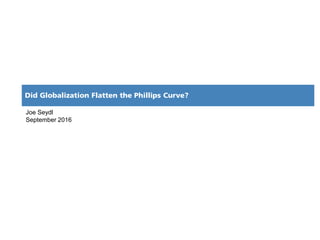Did Globalization Flatten the Phillips Curve?
- 1. Did Globalization Flatten the Phillips Curve? Joe Seydl September 2016
- 2. A dramatic flattening in the slope of the Phillips curve occurred after 1994 2
- 3. Post-1994 is also when we saw a decoupling of goods inflation from services inflation 3
- 4. There is no evidence that goods prices in the US are even related to domestic labor slack anymore 4 Using:
- 5. Goods prices are more related to import prices; we think because of the unprecedented outsourcing of US manufacturing to China in recent decades 5
- 6. So is the Phillips curve broken? Well, no: there’s still a relation between labor slack and services inflation 6
- 7. But the Phillips curve slope for services appears to have flattened considerably 7
- 8. We buy into the Autor et. al. view that outsourcing to China created a glut of displaced workers seeking employment in low-wage domestic service sectors. We think this is what flattened the services Phillips curve slope. 8 “a negative shock to local manufacturing reduces the demand for local non-traded services while increasing the available supply of workers, creating downward pressure on wages”
- 9. Our view has important implications for Fed policy, as with the unemployment rate approaching conventional NAIRU estimates, some are arguing for tighter monetary policy 9
- 10. Fortunately, the Fed is starting to get it: the FOMC has been revising down it’s estimate of the NAIRU and is showing a preference for being behind the wage inflation curve 10
- 11. This is good. The last time the Fed fell behind the wage inflation curve (late-1990s), those at the bottom saw real wage gains on par with those at the top. 11
- 13. 13
- 14. 14
- 15. 15
- 16. 16
- 17. 17
